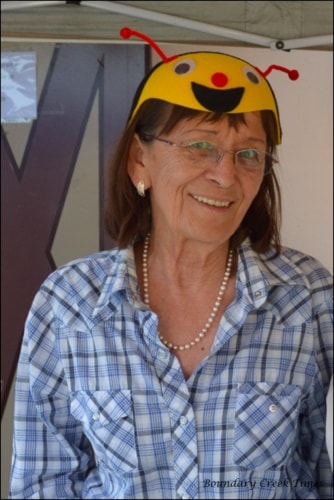“The honeybee is now the canary in the mine,” said Osoyoos apiarist (beekeeper) Sue Harvey on the phone the other day, “and at least 25 to 35 per cent of the hives are dying off each winter.”
Harvey had come to Midway last Saturday to deliver an afternoon workshop on the honeybee for the West Boundary Sustainable Foods and Resources Society (FAR).
“What I wanted to do was introduce bees to local people who may be interested in keeping them. I think the Boundary country could be a great place to keep bees because of the lack of toxic chemicals that are used in many other places where bees are kept.”
“You in that area have a better chance as a backyard beekeeper. If you’ve got a couple of hives there is a 90 per cent chance that your honey is not going to be tainted with toxic chemicals.”
She said that the ecological balance has shifted. “In Osoyoos we have a lot of toxic chemicals that are not only sprayed on the fruit trees but eventually end up in our water system; and bees drink water.”
Harvey told the nearly two dozen people who attended the workshop (including two from Kelowna and three from Grand Forks) that honeybees are not native to North America; that the plants native to North America were reliant on the native pollinators such as bumblebee, wasps, hornets and other different kinds of insects.
But with the introduction of plants from Europe, they needed to bring honeybees over too.
“If you have only one tree in your back yard the bumblebees and the hornets and all the other wild pollinators would probably do it. But when you got 50 trees that doesn’t work, you need to get honeybees.”
She listed apples, cherries, almonds, alfalfa, onion, broccoli and cauliflower as some of the plants that require pollination by the honeybee.
She estimates it would take a maximum of $500 to get set up with a couple of hives. “It depends on whether you make the equipment or buy it,” she said.
The bottom line is - bees are like your houseplants, your dog or your husband – the more attention you pay to them and look after them the better they will do.
Harvey has been keeping bees for 40 years. She has spoken in Australia and worked with bees in the U.S., New Zealand, Australia and Canada.
If you want more information you can call Harvey at 250-495-7065. “I’ve got an education and I would love to pass it on. If this is the path that you chose to go then there is a place where you can go.”
“It could be economically viable in that area with a better chance of surviving than in an area with heavy pesticide use,” reiterated Harvey.
